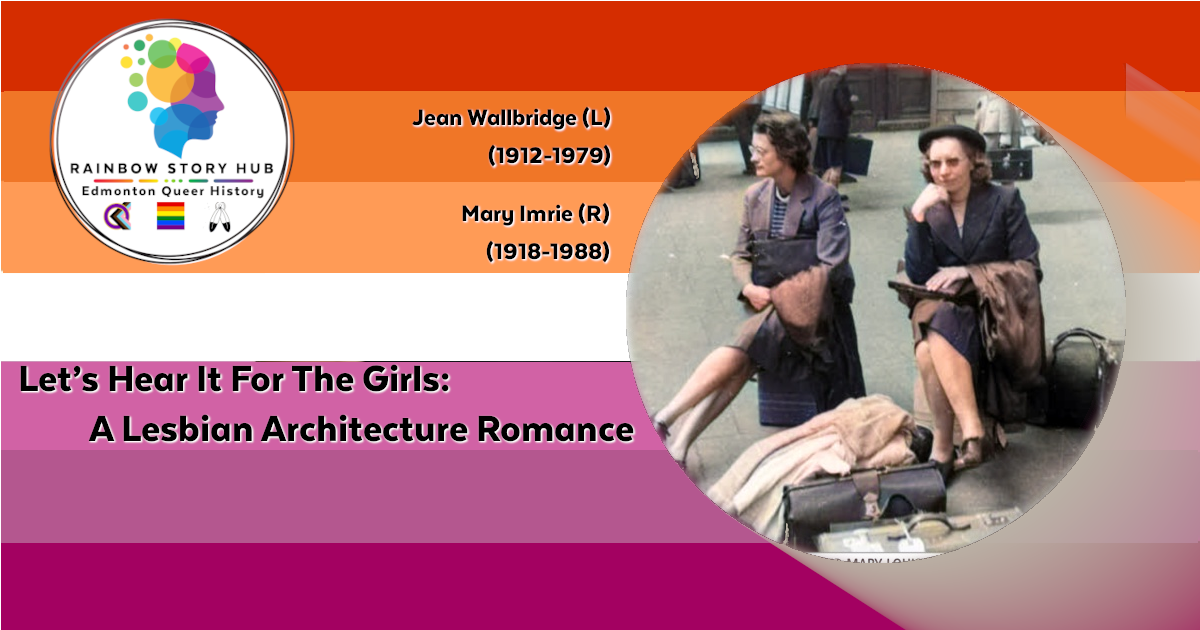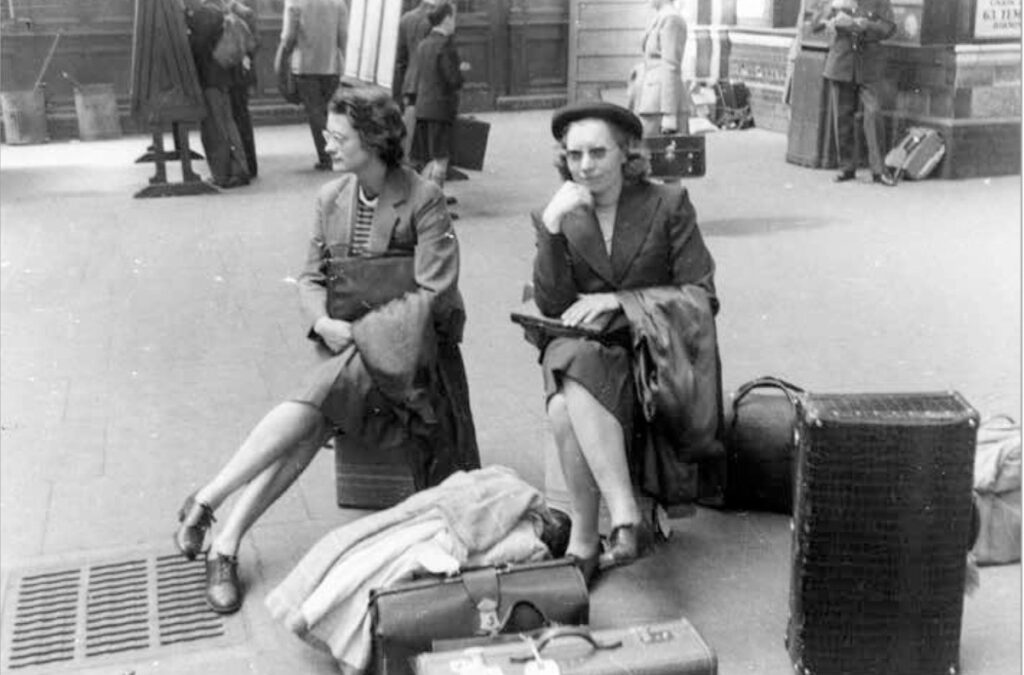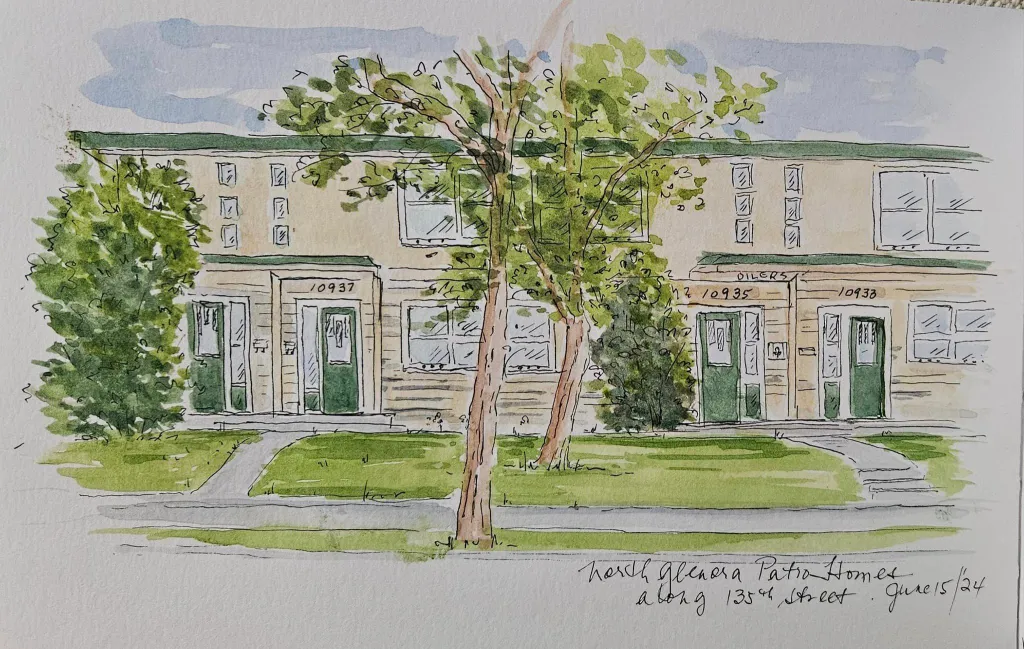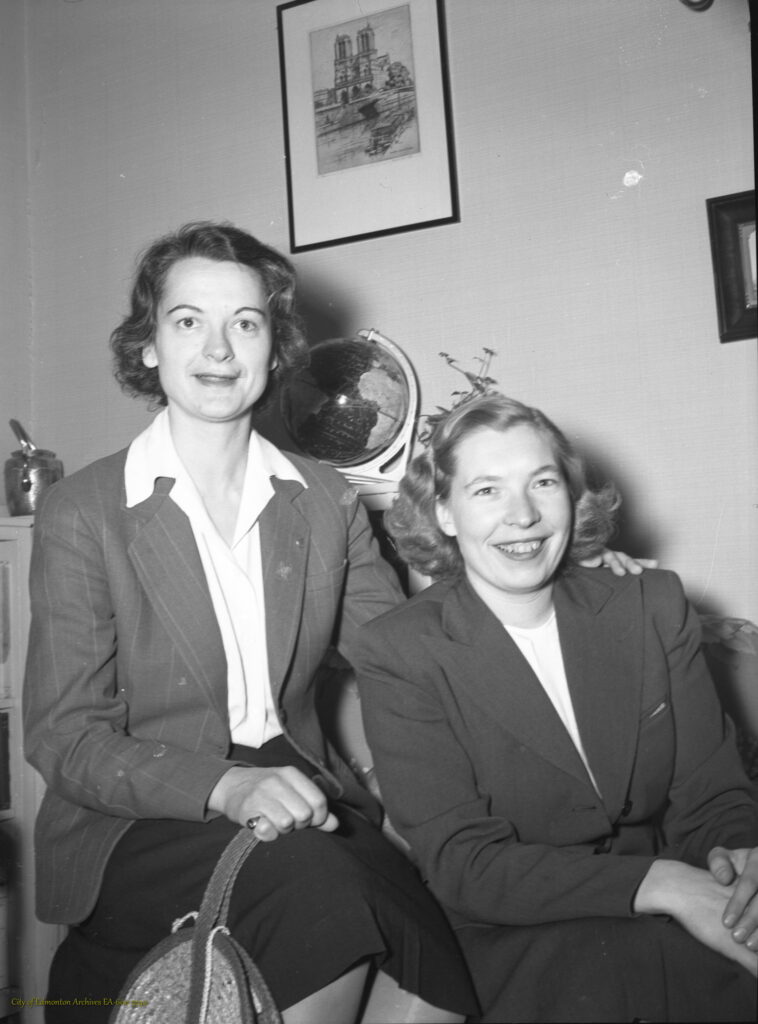Let’s Hear It For The Girls: A Lesbian Architecture Romance

I wake up to the sounds of construction and stumble bleary-eyed down the stairs in a tank top and checkered PJ pants. My heart is in my throat; in the haze of the early morning, my brain has convinced itself that the good luck has finally run out, that my house — one of a handful of North Glenora Patio Homes — is finally scheduled for demolition. The Sword of Damocles has been dangling above me and my partner since we moved in more than four years ago. There was always an asterisk on all of those initial move-in conversations — “Oh, we’d absolutely love to have you! These properties are beautiful. There are some attempted, uhm, redevelopment efforts that have been gestating, but don’t worry about that for now.”
Little warnings tacked on to otherwise innocent conversations. Go ahead, fall in love with these cozy little townhouses, but know that someday, someone will show up with the City’s blessing and a Cat bulldozer and smash your house and memories into the dust like the opening of Hitchhiker’s Guide to the Galaxy. This beautiful neighborhood, surrounded by parks, churches, plenty of public transit access, is a pocket of Eden. Over four years, I’ve seen this fight, this push and pull raging. Newsletters warning us that it’s really going to happen this time. Town halls where residents beg city planners to stop apartment companies from moving forward. Historically-minded public servants deftly blocking the corpo advances with this loophole or that obscure bylaw.
Signage goes up, announcing imminent destruction. Signage is taken down, replaced by promises of low rent and safe spaces, rent now! This happens at least twice yearly.
The rental company has functionally given up answering all but the most dire maintenance requests, and even then they drag their feet. A basement flood takes weeks to rectify; a ceiling pouring water goes unaddressed for two months. There are days I get the sense they’re waiting for us to give up and fold, to roll over and leave.
So hearing industrial equipment so close to my doorstep evokes a specific holy terror, this morning. I stumble outside to attempt to negotiate, to explain we weren’t warned, to beg them to come back later. Four men in hi-vis vests, chatting, laughing, talking about women. I brace myself, prepared to use all of my situationally-limited feminine wiles to convince a bunch of straight men to please, please leave us alone for just a little bit longer.
This is unnecessary. The construction team turns, they see me, and they smile. As the morning haze clears from my eyes, I see that they’re all women. Women talking about dating women. One of them waves to me — “Good morning, miss! Sorry if we woke you. Asphalt resurfacing.” She points to a machine laying tar on the road and my entire body relaxes. The houses will not be bulldozed today, and I can kiss my beautiful partner in front of the open window without fear of being leered at. It feels fitting — not only that a bunch of lesbians put me at ease, but that my bright little lesbian life is rooted here, in these houses.
To destroy the North Glenora Patio Homes is to destroy a piece of Edmonton’s broader history, sure, but also would be erasing a landmark queer achievement. These homes were designed and executed by Jean Louise Emberly Wallbridge and Mary Louise Imrie; Edmonton hometowners and some of my personal heroes. Colloquially referred to as ‘The Girls’, Wallbridge and Imrie were among the first women in Canada to form their own architectural partnership. They were not only trailblazers in a male-dominated field but also set new standards for domestic and commercial architecture with their innovative designs and collaborative approach.
They were also, crucially, lesbian lovers.
Jean, daughter of a lawyer, grew up in private schools, achieved a Bachelor of Applied Science — the third woman in Alberta to earn an architecture degree.
Mary, daughter of the editor of the Edmonton Journal, was known for a down-to-earth personality and studied architecture at the University of Toronto before moving back to the city after graduating.
Both women were hired on as draftsmen in Edmonton’s Department of the City Architect in 1946; both worked there until around 1949. They both gained crucial professional skills, hands-on experience in public architecture, and an increased network of industry contacts. This is also where they found each other; we don’t know exactly, specifically what drew them to one another, but one has to think that the shared experience of being the sole women in a male-dominated workplace (not to mention the broader field) would have helped them forge a bond quicker. I get a kick thinking of what those fleeting workplace glances would have felt like — when did they first spend time together outside of work? Who was the first one to confess feelings, which of them was brave enough to risk “ruining the friendship” for the chance to grow closer?
In 1950, during Edmonton’s post-war construction boom, Wallbridge and Imrie decided to start their own architectural firm, Wallbridge & Imrie Architects. Their timing was fortuitous, as the demand for new housing and other buildings was high. The firm specialized in residential architecture but also undertook various commercial projects. Their work was characterized by a modernist design — simple lines, functional interior layouts, and a strong connection to the surrounding environment.
The Girls completed 224 projects between 1951 and 1979, including 67 private residences, 50 apartments, three senior citizen complexes, and 23 commercial structures. They were known for their attention to detail and their commitment to designing homes that reflected the desires and needs of their clients; they were listeners and artists just as much as they were “good architects” — they played off each other, helped each other.
It can be easy to separate a queer woman’s person life from her work — not so for The Girls. The North Glenora Patio Homes that I live in were discreetly intended for use by queer couples, with the upstairs featuring neighboring bedrooms (one large and one small) that I am told were for the purposes of ‘plausible deniability’, which makes me smile. Even today, I find myself referring to my darling wife as my ‘roommate’ or ‘best friend’ to maintain safety, to spare blushes in certain company. We share the large bedroom, but there might have been a time when one of us would have had to pretend to live out of the other room.
You get the sense that these were women who loved what they did as much as they loved collaborating. Refusing to pigeonhole themselves, The Girls designed the St. James Roman Catholic Church in Edmonton — Mary was, by all accounts, an Atheist (no word on Jean but one has to wonder given the lesbianism) and yet she and her partner created something legitimately beautiful in both form and function.
Another of their notable projects was the Queen Mary Apartments in Edmonton, a three-building complex with 10 suites per building. The complex is still recognized today for its well-landscaped courtyard and thoughtfully designed interiors. It was one of their first projects, marking the beginning of their successful career in inviting, functional spaces and established their reputation as a professional duo act.
Their own home and office, “Six Acres,” was another notable project that reflected their design philosophy. Located on a six-acre lot overlooking the North Saskatchewan River, the house featured post and beam construction, an open-plan layout, and large windows that offered stunning views of the river. The design emphasized natural materials, with an exterior of rough common stone and cedar cladding, blending the building seamlessly with its natural surroundings.
Despite their success, Wallbridge and Imrie faced significant challenges as women — and again, discreetly queer women — in a field dominated by men. In a 1954 letter to her former professor, Eric Arthur, Mary Imrie lamented, “If only we got more, bigger jobs and fewer headachy ones, we would be considerably wealthier and happier. But that is probably one of the disadvantages of being female. People will get us to do their houses, be thrilled with them, and go to larger male firms for their warehouses or office buildings.”
Their projects were often limited to residential architecture — the high-tag bounties and larger, more lucrative contracts were going to their male counterparts. The gender bias was of course common in the post-war period, when returning male veterans often displaced women who had taken up jobs during the war. However, Wallbridge and Imrie persevered, and their firm remained active for nearly three decades.
The Girls were not only partners in business but also in life. Known for their love of adventure, they traveled extensively, often documenting their journeys and drawing inspiration from different architectural styles around the world. They shared a deep personal connection that enriched their professional collaboration, which is something inspirational and aspirational for me. My partner is a web developer and I’ve had the honor and joy of getting to write copy for websites they’ve developed; in a perfect world, I’d get to to do it more frequently — Wallbridge and Imrie lived a kind of sapphic dream in which their shared experiences deepened a profound sisterhood. They were true friends, romantic partners, feminists, and successful career women in a time where not everyone was able to be; hell, a lot of queer women are denied those life bonds now.

PROVINCIAL ARCHIVES OF ALBERTA, PR1988.0290.0853.
Their commitment to their profession and each other was evident in all aspects of their lives. They often hosted impromptu parties and work bees, blurring the lines between work and leisure in a way that suggests that they truly loved what they did for a living. Their home, Six Acres, became a hub of activity, reflecting their dynamic personalities and love for life.
Jean Wallbridge passed away in 1979, and her partner Mary Imrie retired from architecture shortly thereafter. Mary left a significant bequest to the Province of Alberta upon her death in 1988, to be used for environmental conservation, a shared passion for her and Jean. Six Acres was donated to the province and is now known as “Imrie House,” serving as the headquarters of the Land Stewardship Centre of Canada.
Jean Wallbridge and Mary Imrie left an indelible mark on Canadian architecture, breaking new ground as female architects and creating a legacy of thoughtful, client-centered design. Their work is remembered for its simplicity, elegance, and integration with the natural environment. Despite the gender biases they faced, they remained true to their vision and created spaces that continue to inspire. Their partnership, both personal and professional, is a testament to their pioneering spirit and dedication to their craft. Every day I wake up in a warm, quiet house with my partner laying next to me in bed, I find myself thanking them like patron saints, feeling like I’m doing right by them by living as my authentic self. Here’s to The Girls — may pieces of your life and love and brilliant sapphic souls always remain in Edmonton, one way or another.
Watch this video from the Royal Alberta Museum on their collections of artifacts from Wallbridge & Imrie
Additional reading:

Aldynne Belmont
Aldynne H. Belmont is an American-Canadian lesbian, writer, lover of storytelling, and sometimes-showgirl, in that order. Aldynne has happily become entangled in the wide and wonderful web of YEG’s queer scene since moving to the city in 2020, and is a graduate of Edmonton’s own University of Alberta with a Bachelor’s in English and Film.
Her published work includes essays, journalism and theatre. Most recently, her stage play Ride Lyke Hell — described as a “lesbian friends-to-lovers romantic-comedy road-trip post-western” — debuted as a stand-out at Theatre Network’s Nextfest 2024.
She is both proud and absolutely giddy to be making a “serious, grown-up girl career” of the written word. Aldynne lives with her beautiful partner, two cats, and a very loud little dog in a townhouse designed by Wallbridge and Imrie.
Spread the word! Share this story now
108Shares
Advertisements











